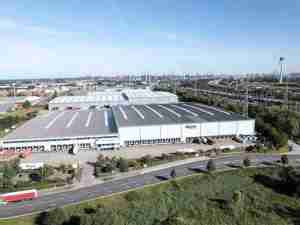The biggest part of the improvement came thanks to cleaner technology, not from a slowdown in cargo. The 2008 Air Emissions Inventory reports that while the amount of cargo moving through the Port of Long Beach declined by 3 percent in 2008 (compared to the baseline year 2005), air pollution was cut much further due to efforts to reduce emissions from vessels and vehicles that operate at the Port.
Overall, it was the Port’s best air quality report card since the studies began in 2002.
Air quality initiatives such as the Clean Trucks Program which began in October 2008, the expanded Green Flag vessel speed reduction program, the use of low-sulfur fuel for ships, and the first use of shore power for ships at berth have all contributed to significant air improvements at the Port.
“I’m very encouraged by this study,” said Nick Sramek, President of the Long Beach Board of Harbor Commissioners. “Speaking as a resident of the Westside of Long Beach, this is a critical public health issue for our community. It’s imperative that the Port meets or exceeds the aggressive goals in our Clean Air Action Plan.”
The CAAP, adopted in 2006, set a Port-wide goal of reducing air pollution by 45 percent by 2012. This study hints that the goal could be met even sooner, Sramek said.
“We have a major Clean Trucks milestone coming on January 1, 2010, when several thousand additional dirty trucks will be banned from shipping terminals,” Sramek said. “With this and other programs now in place, there’s no doubt we’ll meet the CAAP goal by 2012, and probably much sooner.”
In addition to the 21 percent drop in diesel particulate matter, the 2008 Air Emissions Inventory also showed a 12 percent decline in smog-forming nitrogen oxides (NOx) and an 18 percent drop in sulfur oxides (SOx). Greenhouse gases were cut by 7 percent.
The Air Emissions Inventory is a comprehensive accounting of emissions from Port of Long Beach-related cargo movement and is developed with the cooperation and participation of Port tenants and shipping lines. The Port gathers activity data to calculate emissions from each kind of vehicle, for example a yard tractor, and finds out how many of those vehicles are operated and for how many hours. Then the total emissions are calculated to create an estimated “inventory” of pollutants over a year.
While the 2007 inventory recorded improvements in some categories, the 2008 inventory is the best since the reports were started in 2002 and then re-launched on a yearly basis in 2005.
Declining cargo shipments had some effect on the pollution levels, but not a major one. During the study period, the amount of cargo shipped through the Port dropped by 3 percent, and there was a 4 percent drop in visits by container ships. (The following year, 2009, the Port experienced further drops in cargo because of the global recession. The inventory for 2009 will be completed next year.)
Trucks serving the Port emitted about 20 percent less pollution overall compared to 2005. For oceangoing vessels, there was a 26 percent drop in diesel particulate matter emissions.
Harbor craft, which includes tugboats and service vessels, was the only category of sources to experience an increase in pollution, of about 25 percent, largely due to an increase in the use of such vessels. Improvements in harbor craft emissions are expected in coming years.









